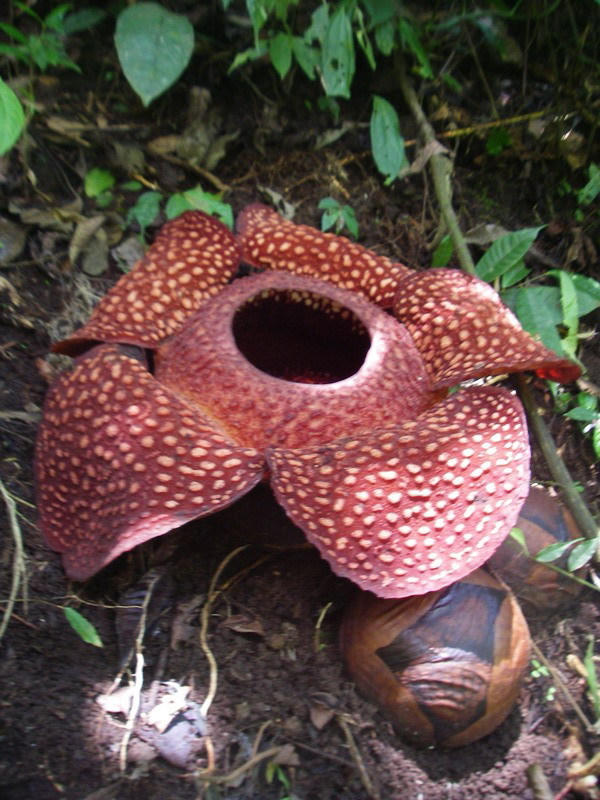- Rafflesia arnoldii
Taxobox
name = "Rafflesia arnoldii"

image_width = 200px
image_caption = "Rafflesia arnoldii" flower and bud
regnum =Plant ae
divisio =Magnoliophyta
classis =Magnoliopsida
ordo =Malpighiales
familia =Rafflesiaceae
genus = "Rafflesia "
species = "R. arnoldii"
binomial = "Rafflesia arnoldii"
binomial_authority = R.Br."Rafflesia arnoldii" is a member of the genus "
Rafflesia ". It is noted for producing the largest individual flower on earth. It occurs only in therainforest s ofSumatra andBorneo in theMalay Archipelago . Although there are some plants with larger flowering organs like theTitan Arum andTalipot palm , those are technically clusters of many flowers. Recent molecular taxonomy studies have resulted in assigning "Rafflesia arnoldii" to the family ofEuphorbiaceae [Davis et al. 2007] .Description
Several species of "Rafflesia" grow in the jungles of southeast Asia, including the Philippines. Many of them are threatened or endangered. The flower of "Rafflesia arnoldii" is the largest which attains a diameter of nearly one meter (3 ft) and can weigh up to 11 kilograms (24 lb).
It lives as a
parasite on the "Tetrastigma " vine, which grows only in primary (undisturbed) rainforests. "Rafflesia" lacks any observable leaves, stems or evenroot s, yet is still considered a vascular plant. Similar tofungi , "Rafflesia" individuals grow as thread-like strands of tissue completely embedded within and in intimate contact with surrounding host cells from whichnutrients andwater are obtained. Perhaps the only part of "Rafflesia" that is identifiable as distinctly plant-like are the flowers; although, even these are unusual since they attain massive proportions, have a reddish-brown coloration and stink of rotting flesh, which is why it was nicknamed the "corpse flower". This scent attracts insects such asflies which then pollinate the rare plant. It is not to be confused with theTitan Arum , "Amorphophallus titanum", which is also commonly referred to as the "corpse flower".Reproduction
"Rafflesia arnoldii" is rare and fairly hard to locate. It is especially difficult to locate the flower in forests as the buds take many months to develop and the flower lasts for just a few days. The flowers are unisexual and thus proximity of male and female flowers is vital for successful pollination. These factors make successful pollination a rare event. [ [http://homepages.wmich.edu/~tbarkman/rafflesia/Rafflesia.html Western Michigan University Biological Sciences page] ]
Survival
How many of these strange plants still survive is unknown, but as the remaining primary forests of Borneo and Sumatra disappear, it can only be assumed that their numbers are dwindling. Many are known to be nearing
extinction . Someenvironmentalist s are thinking of a way to recreate the species' environment, in an effort to stimulate a recovery in the population of this endangeredspecies . This has proved unsuccessful so far, but the efforts have continued. However, steps are being taken to conserve the forests of Sumatra and Borneo.References
External links
*http://www.lostworldarts.com/images/img350.jpg
*http://homepages.wmich.edu/~tbarkman/rafflesia/Rafflesia.html
Wikimedia Foundation. 2010.
